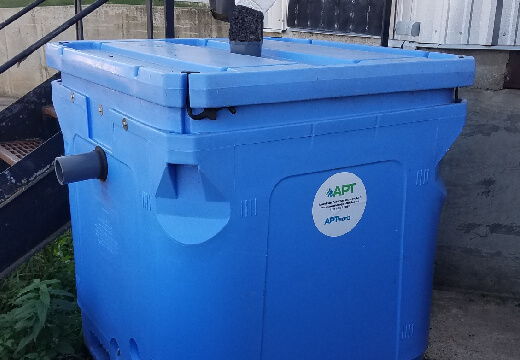Industrial Roof Runoff
Stormwater Treatment: Simplified
Meet the TurnAbout® Upflow Downspout Filter™, a simple solution to commercial runoff water challenges.



Managing Roof Runoff Has Never Been Easier
If your stormwater treatment plan calls for roof runoff remediation, the TurnAbout Upflow Downspout Filter (UDF) is a natural solution. The TurnAbout UDF, manufactured by our parent company, American Peat Technology, simplifies heavy metal removal and transforms commercial buildings into part of the stormwater solution. Capture the power of peat to solve your roof runoff challenges.
How It Works
The TurnAbout UDF treats industrial water runoff with all-natural, responsibly sourced peat. It delivers effective water runoff control with no power requirements and very little maintenance.
- Install: Connect the TurnAbout to the gutter and downpipe system.
- Wait for Rain: The TurnAbout collects rainwater, which flows through a bed of peat media.
- Let the Peat Work: Peat naturally attracts and bonds dissolved metals.
- Discharge Clean Water: Clean water exits the TurnAbout. Metals remain in the peat media.
- Replace Peat Media: Periodically replace the peat media (approximately every 6 months).
Transform Your Stormwater Treatment Strategy
Each TurnAbout UDF is sized to treat up to a half-acre of roof area with a design flow rate of up to 50 GPM. Multiple downpipes can be directed into a single unit, or additional units can be plumbed in parallel to treat larger surfaces. When operating within the design parameters and with scheduled maintenance, the TurnAbout will provide years of headache-free service.
Can I use the TurnAbout in applications other than roof runoff?
Absolutely! The TurnAbout can be used in a pump-and-treat system or other passive systems to remove dissolved heavy metals in any application.
What metals will the TurnAbout remove?
The peat media within the TurnAbout will remove lead, copper, cadmium, zinc, chromium, nickel and cobalt.
How much metal does the TurnAbout remove?
The removal efficiency of the peat media is subject to the metal, metal concentration, speed of flow and system design. In general, removal efficiencies to below detection limits are possible, and loading capacities in the range of 3-8 mg metal/g media can be expected.
How will I know when to replace the peat media?
We recommend periodic monitoring of the media or effluent to detect elevations in metals. The media will not fail catastrophically, so replacement can be planned well in advance.
What should I do with the spent media?
Disposal of any sorption product is dependent on local regulations and how the media was loaded. We recommend performing a TCLP test (EPA 1311) or total constituent analysis on the media. For most metals, with the exception of lead, under normal loading conditions, we anticipate the media will pass the TCLP and will not meet the definition of hazardous waste.